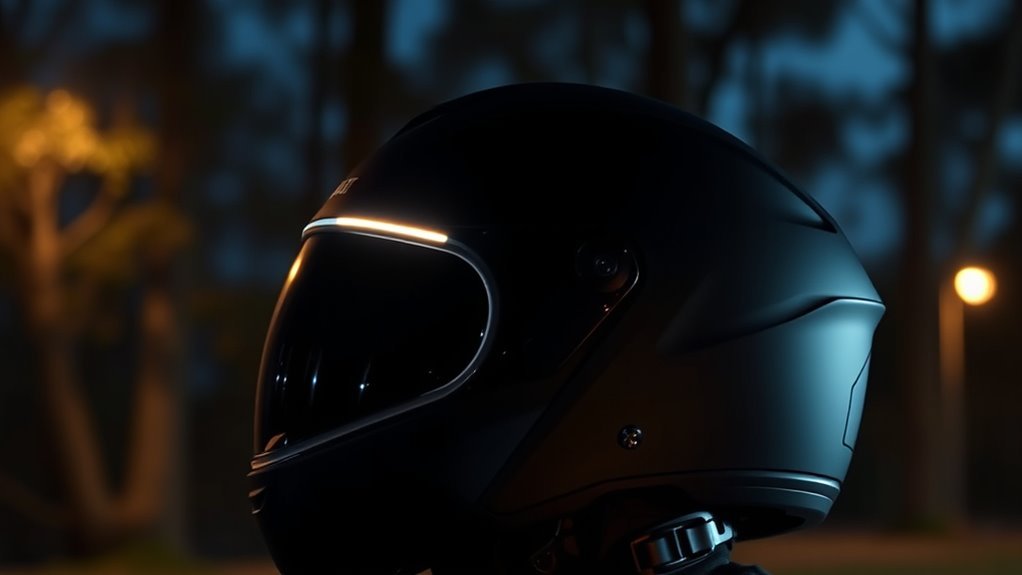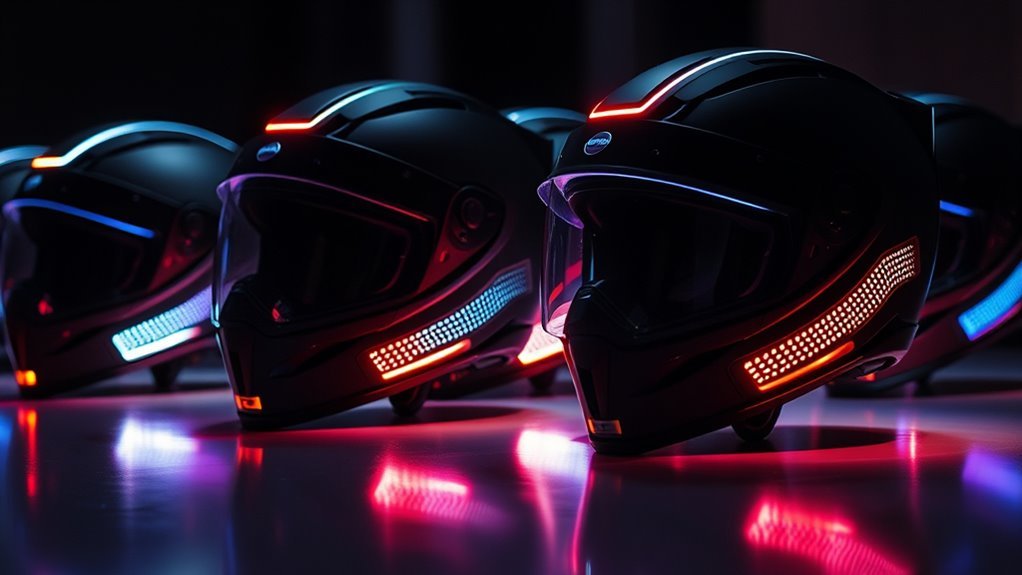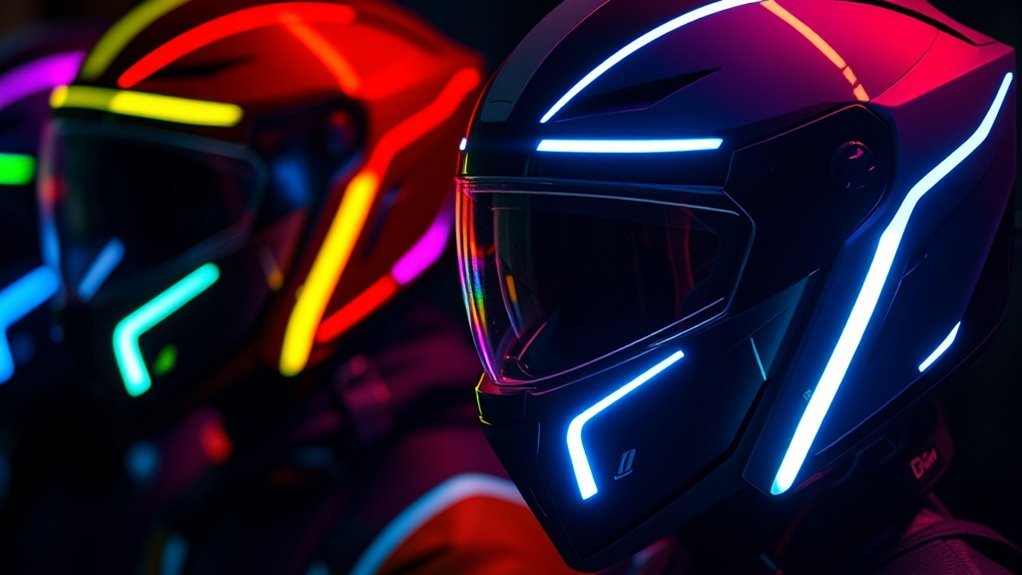Helmets With Integrated Lighting Systems
Helmets with integrated lighting systems are designed to enhance your visibility and safety in low-light conditions. These helmets use advanced LED technology for ideal light diffusion, ensuring you’re seen from various angles. With features like adjustable brightness and customizable lighting modes, you can adapt to different environments seamlessly. The lightweight design provides comfort, while rechargeable batteries eliminate the hassle of frequent replacements. As you explore the latest options, you’ll discover even more innovations shaping helmet safety and functionality.
The Importance of Visibility in Low-Light Conditions

When you’re maneuvering through low-light conditions, visibility becomes essential for your safety. You face significant visibility challenges that can impair your ability to navigate obstacles or perceive hazards. Low-light environments often diminish your peripheral vision, making it crucial to enhance your visibility. Safety enhancements, such as reflective gear and integrated lighting systems, can dramatically improve your situational awareness. These systems not only illuminate your path but also make you more conspicuous to others, reducing the risk of accidents. By adopting these technologies, you empower yourself to explore freely while prioritizing your safety. In low-light situations, ensuring you’re seen and can see is important for enjoying your adventures without unnecessary risks.
How Integrated Lighting Systems Work

Integrated lighting systems in helmets utilize advanced technology to enhance visibility and safety during low-light conditions. These systems often incorporate LED lights that provide ideal light diffusion, ensuring a wide distribution of illumination without harsh glares. You’ll find that the strategic placement of these lights is designed to maximize their effectiveness, allowing you to be seen from various angles. Battery efficiency is vital; modern helmets typically feature rechargeable batteries that last for extended periods, minimizing the need for frequent charging. Some systems even include sensors to adjust brightness based on ambient light, further conserving energy. By understanding how these systems work, you can appreciate their role in improving your safety while enjoying the freedom of outdoor activities.
Benefits of Using Helmets With Built-In Lights

Using helmets with built-in lights greatly enhances your safety during night rides or in low-visibility conditions. These helmets offer significant safety enhancements that can prevent accidents by increasing your visibility to others. Plus, they provide user convenience, eliminating the need for additional lighting equipment.
| Feature | Benefit |
|---|---|
| Integrated Lights | Enhanced visibility |
| Rechargeable Battery | No battery changes needed |
| Adjustable Brightness | Customizable lighting |
| Lightweight Design | Comfortable wear |
With these features, you can ride freely without worrying about safety. The combination of convenience and visibility creates a safer environment, allowing you to focus on the ride ahead, knowing you’re well-equipped for any conditions.
Popular Models and Features to Consider
As you explore helmets with integrated lighting systems, it’s essential to evaluate popular models and their standout features. Brands like Lumos and Torc offer innovative designs with built-in LED lights, ensuring visibility during your rides. Look for helmets that provide customizable lighting modes, such as steady, flashing, or turning signals, enhancing your safety on the road. Additionally, consider design features like lightweight materials and adjustable fit systems, which contribute to comfort during extended use. Some models even integrate with smart technology, allowing you to control lighting via a mobile app. By selecting a helmet that combines functionality and style, you can enjoy the freedom of the road while staying safe and visible.
The Future of Lighting Technology in Helmets
While advancements in helmet technology have already improved safety and visibility, the future of lighting systems promises even greater innovations. Imagine helmets equipped with smart materials that adapt to your environment, enhancing your riding experience. These materials could adjust the helmet’s lighting intensity based on surrounding conditions, ensuring ideal visibility without compromising battery life. Adaptive brightness systems will automatically respond to changes in ambient light, offering you the freedom to ride confidently at any time of day. Integrating sensors could allow the lights to signal turns or brakes, improving communication with other road users. As these technologies evolve, helmets will not only protect but also become intelligent companions on your journeys, redefining safety and enhancing your sense of freedom.
Frequently Asked Questions
Are Helmets With Integrated Lighting Systems Waterproof?
Yes, helmets with integrated lighting systems typically include water resistance features, though their effectiveness can vary. When considering a helmet, look for those that have undergone lighting durability tests, ensuring they can withstand exposure to rain or moisture. While many models are designed to be water-resistant, it’s essential to check the manufacturer’s specifications for exact ratings. This way, you can enjoy your rides without worrying about the impact of water on your helmet’s functionality.
How Long Do the Lights Typically Last on a Full Charge?
Imagine you’re on a night ride, steering through darkness like a ship sailing through fog. Typically, the lights on these helmets last anywhere from 3 to 10 hours on a full charge, depending on the intensity settings. Battery life can vary based on usage, so it’s wise to explore various charging options, like USB ports or solar chargers, to keep your adventure uninterrupted. Always check the specifications for ideal performance and freedom on your rides.
Can I Replace the Lighting System if It Malfunctions?
Yes, you can replace the lighting system if it malfunctions. Most helmets with integrated lighting systems are designed for easy maintenance, allowing for straightforward lighting repairs. Check the manufacturer’s guidelines for specific instructions on system replacements. It’s crucial to use compatible components to guarantee proper functionality and safety. Always prioritize quality to maintain the helmet’s performance, giving you the freedom to ride confidently and safely, even in low-light conditions.
Are There Any Weight Differences Compared to Standard Helmets?
Yes, there can be weight differences compared to standard helmets. For instance, a helmet made with carbon fiber may weigh less than traditional polycarbonate ones, offering better weight distribution and comfort. The material composition plays an important role; lighter materials can enhance performance without sacrificing safety. However, keep in mind that added features like integrated lighting systems can affect the overall weight, so it’s vital to take into account your specific needs when selecting a helmet.
Do These Helmets Comply With Safety Standards?
Yes, these helmets comply with safety standards. They typically meet rigorous safety certifications, guaranteeing they provide adequate protection. You’ll find that they undergo extensive testing for impact resistance, which is vital for reducing injury risk during accidents. By choosing a helmet with these features, you’re prioritizing your safety while enjoying freedom on the road. It’s important to check for specific certifications to verify you’re getting a helmet that meets your safety needs.






